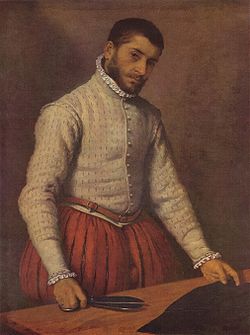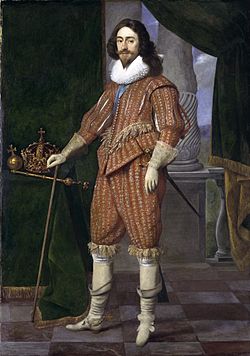- Doublet (clothing)
-
For other uses, see Doublet (disambiguation).
 The unidentified tailor in Giovanni Battista Moroni's famous portrait of ca 1570 is in doublet and lined and stuffed ("bombasted") hose.
The unidentified tailor in Giovanni Battista Moroni's famous portrait of ca 1570 is in doublet and lined and stuffed ("bombasted") hose.
A doublet is a man's snug-fitting buttoned jacket that is fitted and shaped to the man's body which was worn in Western Europe from the Middle Ages through to the mid-17th century. The doublet was hip length or waist length and worn over the shirt or drawers. Until the end of the 15th century the doublet was worn under another layer of clothing such as a gown, mantle, or overtunic. The term also refers to a formal jacket worn with highland dress, a variation of which is called an Argyll jacket or Prince Charlie jacket (or coatee).
Originally it was a mere stitched and quilted lining ("doubling"), worn under a hauberk or cuirass to prevent bruising and chafing. Doublets were frequently opened to the waistline in a deep V. The edges might be left free or laced across the shirt front. If there was space left it might be filled with a stomacher. By the 1520s, the edges of the doublet met at the center front. Then, like many other originally practical items in the history of men's wear, from the late 15th century onward it became elaborated enough to be seen on its own. A similar jacket, the sherwani, is worn today in India.
Throughout the 300 years of its use, the doublet served the same purpose: to give fashionable shape and padding to the body, to support the hose by providing ties, and to provide warmth to the body. The only thing that changed about the doublet over its history was its style and cut.
Contents
History
The doublet developed from the padded garments worn under armour, such as the gambeson, aketon, arming doublet.[1]
Fourteenth and fifteenth centuries
Doublets of the 14th and 15th centuries were generally hip-length, sometimes, shorter, worn over the shirt and hose, with a houppelande or other form of overgown.
From the late 14th century, doublets were cut and padded to give the wearer an egg-shaped or pigeon-breasted silhouette, a fashion that gradually died out in favor of a flatter natural fit.
Later sixteenth century
Through the Tudor period, fashionable doublets remained close-fitting with tight sleeves, but acquired long skirts and elaborate surface decoration such as pinks (patterns of small cuts in the fabric), slashes, embroidery, and applied braid.
In the early Elizabethan period, doublets were padded over the belly with bombast in a "pouter pigeon" or "peascod" silhouette. Sleeve attachments at the shoulder were disguised by decorative wings, tabs, or piccadills, and short skirt-like peplums or piccadills covered the waist of the hose or breeches. Padding gradually fell out of fashion again, and the doublet became close-fitting with a deep V-waistline.
More images:
- Edward VI in an elaborately trimmed and pinked, long-skirted late Tudor doublet under a crimson gown with hanging sleeves.
- Martin Frobisher in a peascod-bellied doublet under a buff jerkin.
- Sir Philip Sidney, when governor of Flushing in the Low Countries, chose to be portrayed in his doublet, but still in a gorget, as if he were caught in the act of setting aside his armour to institute a civil government.
Seventeenth century
By the 17th century, doublets were short-waisted. A typical sleeve of this period was full and slashed to show the shirt beneath; a later style was full and paned or slashed to just below the elbow and snug below. Decorative ribbon points were pulled through eyelets on the breeches and the waist of the doublet to keep the breeches in place, and were tied in elaborate bows.
The doublet fell permanently out of fashion in the mid-17th century when Louis XIV of France and Charles II of England established a court costume for men consisting of a long coat, a waistcoat, a cravat, a wig, and breeches—the ancestor of the modern suit.
Highland Dress
Doublet is also a term describing a type of jacket worn with formal highland dress. This garment is similar to a mess jacket, with buttoned gauntlet cuffs, short or no skirts, and with or without lapels. It may have a row of silver heraldic buttons on each side. It may be worn with a lace jabot and cuff set, and a high-buttoned waistcoat. It is typically made of velvet or wool, with satin lapels, and may feature epaulettes. The highland doublet is jacobean in style and may date to that period or earlier.
The Regulation kilt doublet is a typically black double-breasted jacket with satin peaked lapels, buttoned gauntlet cuffs, and epaulettes, similar to the Prince Charlie coatee, which it pre-dates. Unlike the coatee, which is cut like a mess jacket, the doublet has braided "tashes" (otherwise known as Inverness skirts/flaps) at the front and back. The Regulation doublet was at one time the regulation uniform jacket of the Highland regiments, and is worn with a three-button waistcoat which may be made from the same cloth as the jacket.
The Balmoral Kilt Doublet is a double-breasted jacket traditionally made from velvet. It is usually worn with a belt and black bow tie. It may be worn for both black tie and white tie events.
The Kenmore kilt doublet is a single-breasted jacket, worn buttoned up (no lapels) and without a waistcoat. It is traditionally made from velvet and is always worn with a belt, lace jabot and cuffs. It may be worn on all formal occasions. It is named after the town of Kenmore which lies at the east of Loch Tay.
The Sheriffmuir kilt doublet is a double-breasted jacket with gauntlet cuffs and a stand collar with no lapels. It is typically worn open with a waistcoat, lace jabot and cuffs. Sheriffmuir lies between Dunblane and Stirling overlooking the Allan Water. In 1715 a battle was fought here between the Jacobites under the Earl of Mar and the Government forces under the Duke of Argyll.
See also
- 1500–1550 in fashion
- 1550–1600 in fashion
- 1600–1650 in fashion
References
Bibliography
- Janet Arnold: Patterns of Fashion: the cut and construction of clothes for men and women 1560-1620, Macmillan 1985. Revised edition 1986. (ISBN 0-89676-083-9)
External links
Men's undergarments Upper body Lower body Bikini · Boxer briefs · Boxer shorts · Briefs (slip, Y-fronts) · Fundoshi · G-string · Jockstrap (athletic supporter) · Compression shorts · Thong · TrunksFull body Hosiery Historical Brands 2(x)ist · Abercrombie & Fitch · American Eagle · American Apparel · Andrew Christian · aussieBum · Bonds · BVD · California Muscle · Calvin Klein · C-IN2 · Diesel S.p.A. · DKNY · Dolce & Gabbana · Emporio Armani · Fruit of the Loom · Hanes · Hugo Boss · Jockey International · Joe Boxer · Mundo Unico · Pringle · Saxx Apparel · John Smedley's · Stanfield's · Under Armour · XTG Extreme GameCategories:- Jackets
- History of clothing (Europe)
Wikimedia Foundation. 2010.


